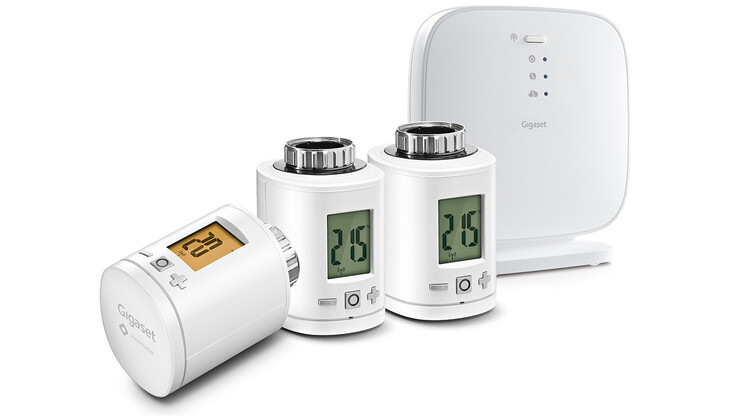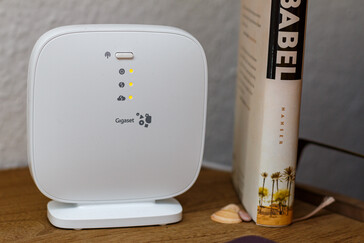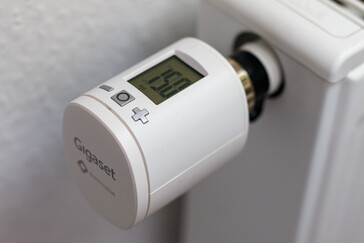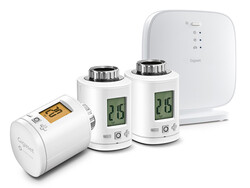Gigaset Heating Pack Review: Efficient smart home heating
Gigaset kindly sent us three thermostats and a base station to test. The system operates on the DECT-ULE standard, which utilises radio frequencies between 1,880 and 1,900 MHz. The decision to develop the system in this way makes sense as it ensures that it will not interfere with Bluetooth connections or Wi-Fi networks that operate on 2.4 GHz. Gigaset competitors like ZigBee use 2.4 GHz for their smart home technology instead, which theoretically gives the former an advantage over the latter.
The Gigaset base unit has a range of up to 50 metres in closed rooms and 300 metres in open spaces, which should give enough coverage for most homes. Other manufacturers also rely on this standard, which makes them compatible with the Gigaset base station. However, it cannot perform firmware updates for third-party modules, so we would recommend staying within one ecosystem until cross-party firmware updates become possible.
The base station is quite compact and weighs only 98 g. Unfortunately, it must be placed in one place and cannot be wall-mounted. Gigaset has favoured function over style too, with an uninspired design. Likewise, the thermostats are bulky but well built. All thermostats have three buttons, two to reduce or increase the temperature and one to set the device at a desired level.
Setup
Setting up the base station is quick and easy thanks to the Elements app, which Gigaset has developed for Android and iOS. All you need to set-up the base station is a wired internet connection and a power source. Any updates can then be processed via the app. Only then should you add thermostats though. The base station can manage up to 48 devices, which should more than enough for most households.
Gigaset requires that the radiator thermostats are attached to a radiator during the setup process, but this is not necessarily that straight forward. Ideally, the Gigaset thermostats would replace any existing ones, but we had to mount ours to our radiators with an adapter. The Heating Pack includes three types of adapters, which are all made from a cheap looking black plastic. They should still be hardy enough for their intended purpose though.
Installing the first thermostat took a while, but we managed to install all three by hand. The base station and app also sent out updates immediately after we had the thermostats up and running.
We spread the thermostats over two floors to test out their range. Positively, we have not experienced any connection problems and cannot detect any transmission delays between the thermostats and the base unit.
Once set up, the thermostats can be programmed with various rules. These include simple routines like setting a timer or more complex ones like turning off the heating if a window is opened. The latter requires optional window sensors though.
Operation
We tested the Gigaset Elements app on Android and iOS with a Huawei Mate 20 Pro and an iPhone respectively. Both apps work just as well as each other, but the Android version supports a wider array of widgets. These did not always update reliably though. By contrast, the iOS widget is limited to displaying basic alarm functions. Both apps are clearly laid out and can be used on the move thanks to cloud integration. Gigaset claims that it hosts the cloud servers in Germany, making them subject to German and EU data protection laws and standards. This is a big plus in our eyes.
Each thermostat runs off two AA batteries. Gigaset has restricted the base station and thermostats to sync every 15 minutes to maximise the latter’s battery life. Hence, it sometimes takes up to 15 minutes for a new desired temperature to sync across the system, but we did not find this an issue in daily use. Gigaset has also included a child-proof mode, which you can activate by pressing and holding the plus and minus buttons simultaneous. You can still control the temperature through the app, but this mode prevents your children from making any unwanted temperature changes.
Smart heating systems are at their most useful in changing weather conditions, which is a polite way to describe the weather in Northern European countries at the turn of spring and summer. We used the thermostat during our test period to preheat the water for our morning shower. The app and thermostats support half-degree increments between 5 °C and 30 °C, for reference.
In principle, the Gigaset system would also work with Philips Hue bulbs. The functionality appears to work well, although we cannot attest to this. It does appear difficult to add a Philips Hue to a rule, although it is not impossible. The act of creating rules is simple enough for less-advanced users to create them without any problems. It would have been nice to have the option to create more intricate, or nested, rules though.
Overall, the thermostats worked reliably during our tests. However, Gigaset has incorporated a small motor within each thermostat that is audible when it is whirring away. We found this particularly annoying with a thermostat placed in a bedroom, for instance.
Verdict
The Gigaset Heating Pack have proved reliable companions during our tests. The pack, which currently retails for €150 (~US$170), contains a base station and three thermostats. Each additional thermostat costs €50 (~US$57) though. In short, the Heating Pack is a good introductory offer into the world of smart heating, even if extra thermostats are pricey. The thermostats are cheaper than competitors’ though, to Gigaset’s credit.
The Gigaset Heating Pack has no weaknesses and is a good introduction into the world of smart home tech.
Overall, we liked the simple set up of the base unit and thermostats. Likewise, the choice to segregate the system from Bluetooth or Wi-Fi connections seems wise, as does the secure cloud integration. The integration of third-party products like Philips Hue is not perfect though, and we would like to see options when creating rule sets.
Gigaset also numerous other products under its Smart Home range including various sensors, cameras and even health care products. Theoretically, these should work with the base unit too.
























